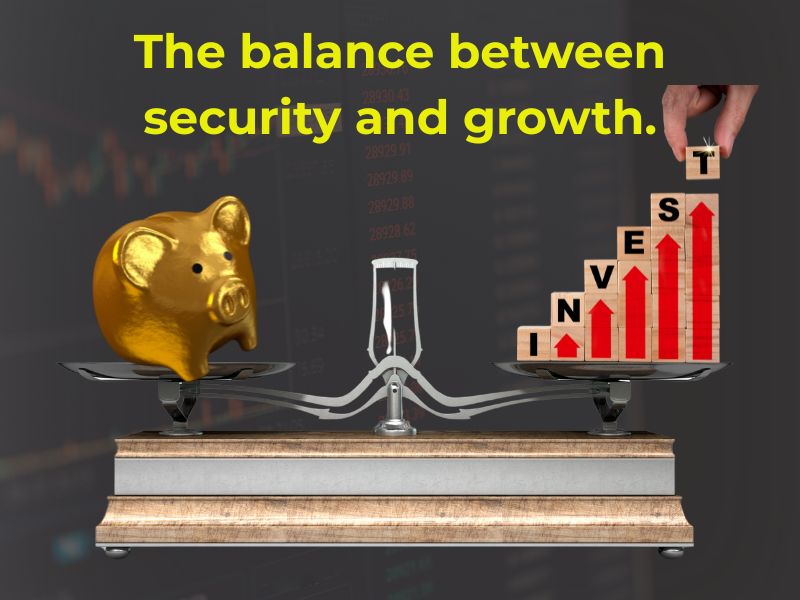If you’re working toward financial freedom, you’ve probably been told to “save your money” or “start investing.” But while both are essential to your financial health, saving and investing are not the same thing — and understanding the difference can dramatically improve how you manage your money.
In this article, you’ll learn how saving and investing work, when to use each, and how combining both strategies creates a strong foundation for financial success.
What Is Saving?
Saving is the act of setting aside money for future use, usually in a safe and accessible place like a savings account or money market account.
Savings are typically used for:
- Emergency funds
- Short-term goals (vacations, car repairs)
- Predictable expenses (insurance, taxes)
The goal of saving is security and liquidity, not high returns.
Pros of Saving:
- Very low risk
- Easy to access in emergencies
- No potential for loss (if held in FDIC-insured accounts)
Cons of Saving:
- Low interest rates (usually 0.5%–4%)
- Won’t outpace inflation over time
✅ Ideal for money you may need within the next 0–3 years.
What Is Investing?
Investing involves using your money to purchase assets (like stocks, bonds, or real estate) with the goal of earning a return over time.
Investments are typically used for:
- Retirement
- College savings
- Long-term wealth-building
- Beating inflation
The goal of investing is growth, and it comes with some level of risk.
Pros of Investing:
- Potential for much higher returns than saving
- Outpaces inflation
- Builds long-term wealth
Cons of Investing:
- Value can fluctuate
- Risk of short-term loss
- Requires time and patience
✅ Best for goals 3+ years away, especially 10 years or more.
Key Differences Between Saving and Investing
| Feature | Saving | Investing |
|---|---|---|
| Goal | Safety, accessibility | Growth, long-term wealth |
| Risk level | Very low | Medium to high |
| Returns | Low (0.5–4%) | Higher (7–10% average in stock market) |
| Time horizon | Short-term (0–3 years) | Long-term (3+ years) |
| Liquidity | High (easy access) | Varies (may require selling assets) |
When to Save vs. When to Invest
Save when:
- You’re building an emergency fund
- You’re planning a purchase in the next 1–2 years
- You want to keep cash safe and liquid
- You’re risk-averse and can’t tolerate fluctuations
Invest when:
- You’re saving for retirement, a home, or a child’s education
- You have time to ride out market ups and downs
- You’re seeking higher returns to grow wealth
Why You Need Both
Saving and investing serve complementary roles in your financial plan.
Saving = stability
- Keeps you afloat in emergencies
- Provides peace of mind
Investing = growth
- Builds future wealth
- Helps achieve long-term goals
A strong financial plan has:
- 3–6 months of emergency savings
- Regular contributions to retirement and investment accounts
- A budget that supports both short-term and long-term needs
Building Your Financial Foundation
Here’s how to combine saving and investing effectively:
1. Start with an Emergency Fund
- Goal: 3–6 months of essential expenses
- Keep in a high-yield savings account
- This protects your investments from being tapped early
2. Pay Off High-Interest Debt
- Before investing aggressively, eliminate debts like credit cards (18%+ interest)
3. Begin Investing Early
- Use tax-advantaged accounts: 401(k), IRA, or Roth IRA
- Invest in low-cost index funds or ETFs
- Even small contributions grow over time through compound interest
4. Save for Short-Term Goals
- Use separate savings buckets for travel, holidays, or big purchases
- Automate transfers to stay consistent
5. Reassess Regularly
- As goals or income change, adjust how much you save vs. invest
- Maintain flexibility while staying disciplined
The Role of Inflation
Over time, inflation erodes the value of your savings. That’s why only saving — and never investing — can leave you falling behind.
Example:
- $10,000 saved today may only be worth $7,500 in 10 years (due to inflation)
- But if you invest and earn 7% annually, that $10,000 could grow to nearly $20,000
✅ Saving preserves value short-term, while investing multiplies it long-term.
Final Thoughts: Balance Is the Smart Strategy
You don’t have to choose between saving and investing — you need both. Saving gives you security, while investing gives you growth. Together, they create a solid financial foundation that can weather emergencies and build wealth over time.
Start by saving for stability, then begin investing for the future. The earlier you begin, the more freedom and choices you’ll have later in life.
FAQ – The Difference Between Saving and Investing — and Why You Need Both.
What is the main difference between saving and investing?
Saving focuses on safety and accessibility, while investing aims for long-term growth. Savings are used for short-term needs; investments are for building wealth over time.
When should I save instead of invest?
You should save for emergencies, short-term goals (like vacations or repairs), and anything you might need within 1–3 years. Savings offer liquidity and low risk.
Why is investing important if I’m already saving?
Investing helps your money grow and beat inflation. While saving preserves your money, investing multiplies it, especially for long-term goals like retirement.
Can I do both saving and investing at the same time?
Yes! A solid financial plan includes both — saving gives you stability, while investing builds your future. Balance is key to reaching your short- and long-term goals.
What’s the first step toward building a financial foundation?
Start with 3–6 months of emergency savings. Then pay off high-interest debt and begin investing early — even small amounts can grow significantly over time.

